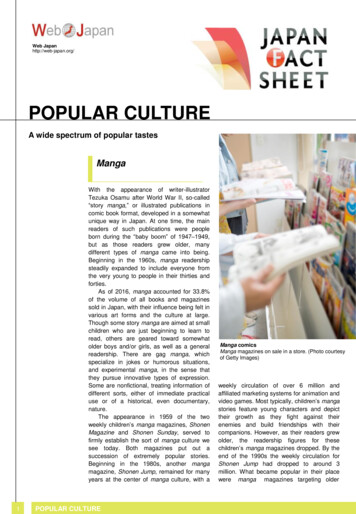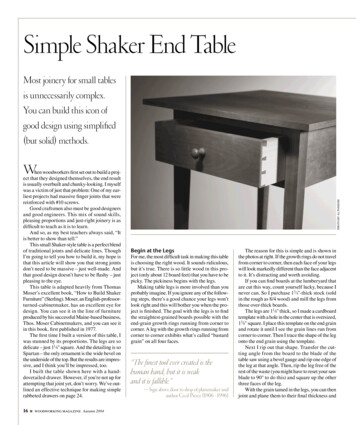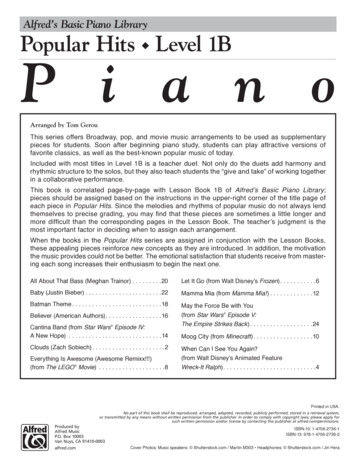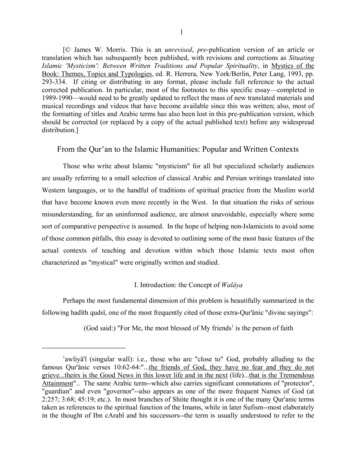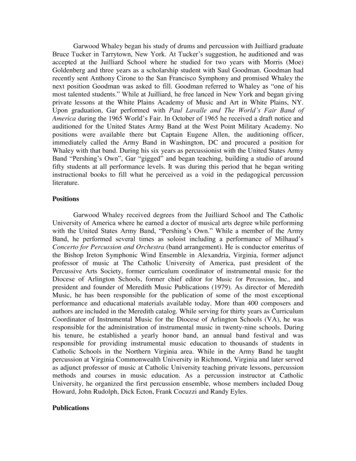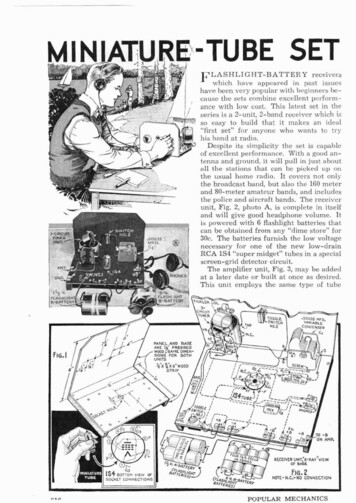
Transcription
n.4oPOPULAR MECHANICS
Flashing Lights 'IBy Albert L. DaughertyD E S I G N E D for t e a c h i n g theprlnclples of the vacuum tube,and a one-tube receiver in radioand science classes, this visualdemonstration unit is housed in al a r g e brightly painted c a b i n e t .The wiring d i a g r a m is made ofcopper, tubing and the various elements have openings behind theirdiagrammatic r e p r e s e n t a t i o nthrough which lights shine in thesame sequence as the electric impulses travel in a real receiver.The openings are covered with red,yellow and green Cellophane sothat the cliirerent electric circuitsare easily traced as a revolvingswitch moves from one set of contacts to another. When the "phone"lights go on a buzzer sounds to indicatethat the program is coming in. PhotosA and B show front and rear views.KEY TO FIG. 1: I-panel;Z - c a b i n c t : 3-Incomingradio wave; 4-R.F. current: 5 a n d la- oils:6--port f o rliaht; ?-gridcondenser a n d grid leak: &port: 9-variable condenser; 10-area painted to indicate triode tube:11-fllarnent;12-aridsymbol: 13-translucentmirrorf o r Plate; 14-area with green Cellophnnc; 15--slot f o rgrid liaht: 16-areabehind plate, yellow Cellophane:17--cond nser: IS-actunlphone caps with yellow lightsi n place of diaphragms: I!l-yellowfor B battery: 26red for A battery; 21-holesrepresenting electrons passI n s from filamcnl; Z%t oles In panel for electrons goingl o plate; 25--cord f o r 115-v supply f o r lights a n d switchAPRIL, 1941615
HOW TO SAVE MONEY ON IEVERYTHING IN RADIONewKits!(;i,t:!,?t l l i i l oi15.000 Parts! 1' 1161 Ilizxest s t . 1 lt!til !i!w m ttrm v t l r z ' i i o ! I ) r t , l t o uof q! :!lils n i l r l % i t , a i l r,sdiu.vIs - I - 1 1 1 i I lk tI:ii,rsIv;ltiinx 111i8k :- ( 01111111 1 to s i c f t - i sII l l s t i n x s ful. P i r r s .;ttiio hr ii,iin!:s i g n % : I.'ltl.:l:I'icl'ls 1.isrs nu reit1111 se .vic.it,n r c q t ? i r r t t:vpl)- nl.IIi IIiLhiltx SOII 18rwl at SIII.tirt el.til)s.r:tdio for c!?rY I l L i I l t rv luI 'c!! l ott't !miss t h i s 7 x l ! l l l S l ? r l r xI. I l lXI Ir y k:\I.I,I F:l) (';11;110pllle rt.lj:tltlc,1s l o furl ;111,I 1.rlfirs nllel! J(IU rrls(l ti ie 10 K c r s t l i t t ci n I l : l i oa1un i\I,I.lF:I)t o h c l l l xu"!tile lotvc.;t pl.i ws!f--Radio Dictiansry. S o t h i n g I k e Builders' Hantlbook. The n s ti t ever irrf0rr.-rolnplrle,slltilori ) l ) t , l i andrl i t l t , l ? S O01I ill1tiltivll.!l.nrll1 n l i l l l l i n e s tllc1t;tclio n ! l l i ? ; t l i ,\l.Llb;I)'s! nricr! Vnrnnli I,? Il?acIirlg I ;ulio a\rn ralualjle b g i r l l l e r 'hooksoo:111111orili 1 llltl ,r;\T,LII:l)strncr1t; dio. TVIIP I1c11v t o SelecL e i r cttits, rc.? I di;fi rdnls. lmilci 1 . I n t r l . r s t i ! l r .\lnatcur I l i l t l l r lwctinn. I.', lly i l l u s I i t l i i it si ,yl o ttn Ier?t. ncl.3 l : t k si t easy 1 0learn l i ; , l i oSend roupon SO\,'! .-1 0 I!"OSc,! l1 -s o t v l 'itlCi21!111 S p r i n g ( 7 a t a l .l n c fur 1l:gdio Diorionnry.I cllelose I l l c fur Ildclio I l l 8 i l l v r r ' l:ln ll ook.I 6mvlad.II CityL--------,,,,,,--- J134AMiniature-Tube Flashlight CellReceiver(Continued from page 617)the 3-circuit-tuner type which has a terminal strip clearly marked for proper connections, greatly simplifying the circuitwiring for the novice. In addition, the coilhas a movable "tickler coil" which makesthe usual volume control or variable condenser for controlling regeneration unnecessary. Two small machine screws are usedto bolt the coil assembly to the front panel.Finally mount the row of Fahnestock clipswith machine screws and nuts, placing around-hole soldering lug under each nut.One extra clip is mounted to connect in thenegative-B lead so that when the loudspeaker stage is added it can be controlledby the same "on-off" switch. The smallround tuning dial plate is fastened to thefront of the panel with china cement.In assembling and wiring these units,follow the diagrams carefully, checkingeach wire as you put it in. Make all connections with rosin-core wire solder making sure that your iron is bright and we11heated. Good mechanical and electricalconnections are important in radio work.Although all parts for both receiver andaudio amplifier arc i n e x p e n s i v e , theyshould be of good quality, and just asspecified. A detailed list of the original1 .partsused in both units, is available fromPopular Mechanics radio department without charge.After the receiver is wired, you areready to solder the flashlight batteries together. Scrape the ends with a sharp knifewhere they a r e t o be soldered to insure agood connection. It will be noted that twoof the cells are connected in parallel forthe 1% volt "A" battery.I.State . IC o n l r c t c dinthismanner the voltage remains at 1% voltsbut the amperage is increased to doublethe usable life of the cells. Use a good set(Continued to p a p 136A)POPULAR MECHANICS
(Continued from page 134A)There's a lot of he-man thrill in a short-waveradio of your own. But the biggest thrill isputting this magic Voice-of.the-World together YOURSELF. Our new FREE radiocatalog No. 8 2 features a wide selection ofBuild-il-Yourself kits and items designed tomake that thrill come true. But that's not all.This big 196 page book also contains thou-IDept.7DIof, preferably new, 2,000-ohm headphones;old phones usually lack sensitivity. To testthe receiver, connect the antenna, and agood ground on a cold water pipe; throwswitch No. 1 "on" and turn the "ticklercoil" until it lines up with the large coil.Now rotate the variable condenser slowly.Whistles indicate stations. When one isheard, rotate the "tickler coil" until thewhistle stops and the station comes in.or -100 Sinn nre., v e Ir urn. .8Please Rush FREE Catalog No. 82.0 .I-:I NAME.IADDRESCg .-.-.-.-I. . . . . . . .,-.-&Az.-.-.-.--. I-TIO1 I s . . f r o m1 l : l i I l i jt x c c nletiiilsl r:!ll l o pu11111gh o t h:irrf-v: rlrly . . . st o\vsa\.l:lus a.lleu Inen:trC cri11ip1 ( 11with .orrec.tinrl11alri: lelores.Si,eed I I v n r k , n v u i linjrlrles, inrrrtlfllls.I u r n s , layorin, h n s i t : l:in11l(.ornlle11satlc 11cxllrnscu. S r n r l linverirnellt for I)ig saviacs.0 1 interest t o CI-CIY e s r r l l t i v e . \Vrlle nowror nnw cst.alo8: r:trety v l n t l i , .:l lrons, sleeacs l e e r i r c s Pllnls. etr. .AS00il?ms I n litit-. ' 1: nci:trd'! v i l l i e a , l I l g in(IuStrIal . \Vrltc lotlay.slaves.INDUSTRIAL GLOVES COMPANY ,# ,* - * ,.""'*,732 Garfield Blvd. Danville. llllnois a krnnua uinvrnllun1or now have-aboat-withT l i . I!n ,k nns\rc,r- I h c h i ( i . s t i " \rVr .h ; t* I n ' : l l r l i\!,s. 8 1 , l , i Iu rI t l r , , , m y :i o : t ? ' 'l'1.1Is'11 1!t, t o illst;bil ;u,,l la-,.21s 5rell n r " ! r Vitlnitl,lela".info .nr;ilio x011pl-ot,rlicrs, sll:lflinc. slufllse I oscr. lasll";tnels iinti Oll cr itthoart1 l10!ver a c ( . o r i c s .nil13 dcl: ilsof cnl lnicle lillc Of l t v l \ V i W.\lal.ine Enaisics. Free on reauest.clearly. To tune in short-wave stations,throw switch No. 2 and tune slowly andcarefully a s these stations tune very sharp.Best results on the short wave bands willbe obtained a t night, especially the amateur and police stations. Some of the typeIS4 tubes seem to operate more smoothlyon 4% volts of B-battery. If the set "pops"noticeably as the coil is turned, or breaksinto squeals, use three of the cells in theB-battery instead of the four shown.Construction details for the amplifierunit are clearly shown in Fig. 3 and thebattery connections for using both units inFig. 3-A and photo B. It will be noted thata large No. 6 dry cell is used for the A-battery and that a 4% volt "C" battery and a45-voIt B - h a t t l arc. added: t h e No. 6 drycell replacing the two-cell flashlight Abattery in order to operate both units moreeconomically. Schematic circuit diagramsfor both units appear in Fig. 4. The blueprint number of this article is R-289.POPULAR MECHANICS
THAT CHARLES 1sDOING SO WELL IN HIS '2 GIV r il .t\ Vt .c l(';isp;t!:r,! k , ,c ti . , l c ! L : l \ l . L !)\I?iirilnx,.ni n o, I t , c i : I , : \ I R : l i t l l o r l ! y , S o l r I l ? o r ? - ) l l lr r r d pr-o\. .n.n r t h , r l s ; t n r rnc,;lnslfor day ; t n d n g h lishting, c a b l i n g , troll in . sIIIIf i s h i n g . 11a u i r l e 1,oolc e v e r yb e g i n n t . r and old timer c a n u s e . S e n t Ji.rr,! N ' r i t e t oDELTA ELECTRIC CO.,300 W. 33rd St., M a r i o n . Ind.CC c r n c r ; \ l o r s f u r n i s h A ( ' u r r v n sameti n I l t r . 3;tO l u 1n.OnO s a l t s , l i a rPt4.:OJ; up.,\l o IUI; J'converters.;ISEasy PaymentsXnrnld Jones "rites: "II nclcdn 10 ,oh blne &ratd,. ."I t t a k ronly n IPUdollsraJ. Cranatnn m v a : "Ihaveaarer; i inhs l o atnrt on l Lltiank8 l : I)". ).ourhelp.''CIv lo Drisndt nritoa: "Im:wle I, dc mnstr.c#on i n I,*,,,, ,* .!,,, " , , \ , r , , , . . L : ! l.,,t, ,.,l . , , . : , r . , , , l l : 5 .C.,.! I,.uc,rr, WIV II f.dk rls I.:llui ., nukin,: i l a i i l r ix ip?!r,,i elo,sc Unl,r,.mkrl ll. 11.1, '3 r r l 11) 1iitl.r 8trc.t \ V ! c h rI u4nac. Rcil l; un DllPOR R e s p r t o rrentsFREE.H. S. COVER, Dept PM, South Bond, Ind.PIONEER RESPIUATOR DESICNEII SINCE ISPIa ,,"I li 8?1 8 1:,,, I6"tS\,V O N SCHRADERjBIGPROFITS lasRESTRINGING BADMINTONIt',,H.,!., . o.-?-,,-atxlorolltablo.I,:.j.,.t.rc.tr;, r i 8 s.,I t,,,.".RACKETS" IFREE1BRAND NEW CATALOG!"r"YrnLi':',n:r:tii0t.I , , ' lllnLs l r l n l a 0:C::.t l y!Iltirr,!H. E. W I L L S C0.1047 W.d7thSt.Dsmt. PM-41. Chlraaollli-htlill.rl. rln. r':log iy ile sttill you wcl our( , , I O rc; l M o n e y hlnkcr rlir f , l l l l l O r f . i t l , l \ ' . 15IIIPI. , . i s s f r il I f 11111 ofI,o\rf ; l r t r y lJrj? ' -I;ilhY 'I',TII S.\YtltnI o r E(tii,le itltti Logs nr Calalog.\1 i,.,sdi nca."z::W l T T E E N G l N E WORKS 4,71\z4SgKkf,"::.f o r autoparfs. reflectors. faucets. bicycles.Free particulars.N o tanks necessary.GUNMETAL CO.,AVE. M.APRIL, 1941DECATUR, I L L I N O I Ssllolllcl c smrtedtNO\V.t t n nI,")fur I I , xiluc tncin llla next lew drrsa."ro.tr,,,.t5%l,i?l,\\illlllUlOSEND FOR FREEINFORMATIONT1wr . i s So 0 l a l i : t m o n2gMANUFACTURING CO.
Popular Mechanics radio department with- out charge. After the receiver is wired, you are ready to solder the flashlight batteries to- gether. Scrape the ends with a sharp knife where they are to be soldered to insure a good connection. It will be noted that two of the cells are connected in parallel for the 1% volt "A" battery. Conl rctcd in this manner the voltage remains at 1% volts but the .





